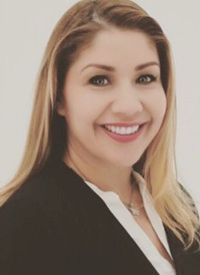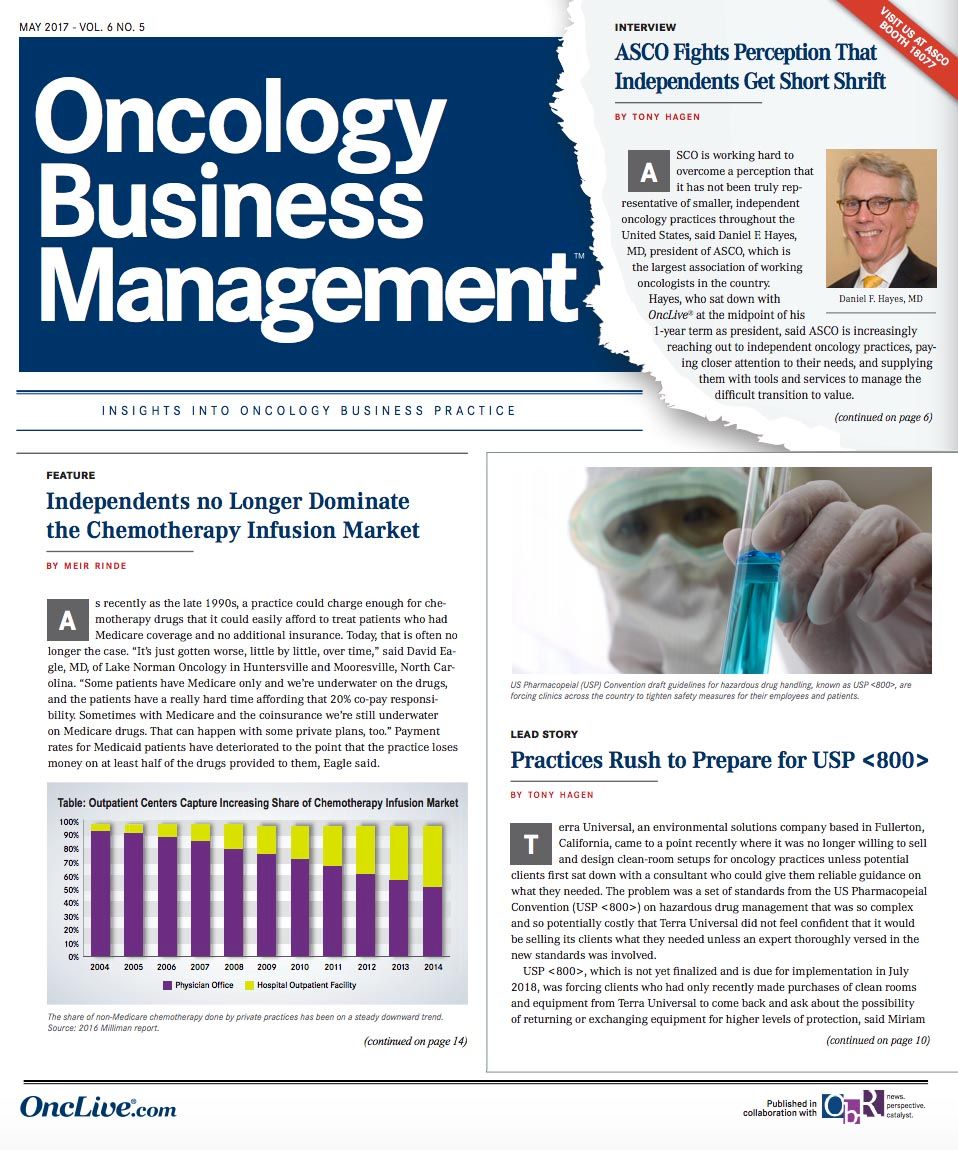Practices Rush to Prepare for USP
Terra Universal, an environmental solutions company based in Fullerton, California, came to a point recently where it was no longer willing to sell and design clean-room setups for oncology practices unless potential clients first sat down with a consultant who could give them reliable guidance on what they needed.
Miriam Magaña, Terra Universal

Miriam Magaña
Terra Universal, an environmental solutions company based in Fullerton, California, came to a point recently where it was no longer willing to sell and design clean-room setups for oncology practices unless potential clients first sat down with a consultant who could give them reliable guidance on what they needed. The problem was a set of standards from the US Pharmacopeial Convention (USP <800>) on hazardous drug management that was so complex and so potentially costly that Terra Universal did not feel confident that it would be selling its clients what they needed unless an expert thoroughly versed in the new standards was involved.
USP <800>, which is not yet finalized and is due for implementation in July 2018, was forcing clients who had only recently made purchases of clean rooms and equipment from Terra Universal to come back and ask about the possibility of returning or exchanging equipment for higher levels of protection, said Miriam selling a lot of USP rooms,” she said. “The problem was they weren’t compliant because we were only going with what the customer was asking for. They would come up with designs and later they found out they couldn’t use the clean room any longer because the regulations were changing.” The stainless-steel rooms that Terra Universal supplies to oncology practices can cost in the tens of thousands of dollars. They are designed to create a “negative” air flow that prevents airborne toxins from migrating to other rooms in a building.
The company solved the problem by engaging a regulatory expert who works with the California State Board of Pharmacy to consult with customers prior to any purchase, for a fee of $2500 for a 1-hour call. That money is credited toward purchases above a certain level, and the consultation can save a lot of frustration down the road, so it’s a wise investment for the oncology practice and it means Terra Universal will have fewer dissatisfied customers, Magaña said. “We will not quote a price without the consultation,” she said. “We got to the point where we just wouldn’t do it. It’s not in the customer’s interest to not do it.”
Figure. Federal Involvement in Toxic Drug Management
USP <800> has the potential to be a game-changer in the field of oncology practice. It is a set of standards for hazardous drug handling that has been developed and has moved toward adoption at a relatively rapid pace compared with its predecessor, USP <797>, which is a set of sterile drug compounding standards that only touches on hazardous drug management (Figure). The new set of standards addresses the type of equipment that should be used for mixing chemotherapy drugs, facility layouts, room air-exchange requirements, and venting standards. These involve huge expense and add to the economic burden already faced by independent cancer centers across the country. Dispensary and pharmaceutical administrators from oncology practices who spoke with Oncology Business ManagementTM said many practices have been caught flat-footed by the advent of USP <800>. Many are scrambling to bring their facilities up to the higher level in time for adoption. The problems encountered along the way include financing, diversion of practice resources, and disruption to clinic operations.
By itself, USP <800> will not carry the force of law. However, the standards are likely to be endorsed by state boards of pharmacy and medicine, which have regulatory power. The US Occupational Health and Safety Administration (OSHA) also is expected to put its heft behind the hazardous drug management guidelines, which were developed over years of increasing evidence that higher standards are essential to protect not just patients but also clinical workers who come into prolonged, daily contact with toxic drug compounds. “The USP <800> standards that are going into effect in July 2018 will be enforceable by a variety of organizations,” said Josh Cox, PharmD, BCPS, director of pharmacy at Dayton Physicians Network, a Dayton, Ohio-based string of 8 oncology centers.
Many regulatory bodies are taking USP <800> very seriously, which has given oncology practice administrators a strong hint that they will have no choice but to comply. “In the state of Ohio last year, the Ohio Board of Pharmacy passed a set of rules that mirror the requirements of USP <800>, so those are actually enforceable now,” Cox said. He serves as a co-chair of the Community Oncology Alliance’s Community Oncology Pharmacy Association and said that although many state boards of pharmacy have yet to take a position on USP <800>, many are considering how they should adjust their rules or what new rules they should write to allow themselves to have jurisdiction to enforce USP <800>.
Wanting to Be Sure That USP <800> Will Happen
Queens Medical Associates of Fresh Meadows, New York, is among many practices that are grappling with the specter of USP <800> standards. The practice is confident that it has much of the appropriate equipment and compliant facility space already in place to protect its workers and patients to the level of USP <800>; however, closing the gap to bring the practice into total conformance would involve huge additional expense and significant disruption, said Howard Levine, PharmD, pharmacy director at Queens Medical.For the practice to justify the cost of full transition, it has to know for certain that USP <800> actually is going to be adopted by the US Pharmacopeial Convention, Levine said. It seems very likely that that will happen, but Queens Medical doesn’t want to make the investment until it is sure. Within the next 6 months, Levine estimated, the practice will have to decide whether to start renovations. Beyond that point, there won’t be enough time to complete the work before the projected July 1, 2018 adoption of USP <800>.
Even though the practice feels that its facilities already are very modern and safe, compliance is important from a legal standpoint, Levine said. With the certainty that many regulatory bodies including OSHA will hold practices accountable, even a small departure from standard could be too much of a risk. “Do we protect our patients to the best of our ability? Yes, we do. Do we protect our workers? We give them any protections they specifically request. So that’s not the issue. The issue is did you follow that regulation?” Levine said.
Even somebody who accompanies a patient for infusions could conceivably make a defensible legal argument that a personal illness resulted from exposure to toxins at the practice that weren’t controlled or contained according to standard, Levine said. “What are you going to do if you can’t prove that you were following regulations? That’s where the concern comes in. You put yourself at risk by not doing the appropriate things. The ultimate endpoint could be you now lose a lawsuit because you couldn’t prove you took steps to protect someone.”
Some Practices Are Further Behind Than Others
Queens Medical sees about 125 to 150 patients each day, has 5 pharmacists on staff, and provides both infusion and oral chemotherapy. Its facility is 12 years old and was designed with the expectation of having to meet USP <797>. In 2014, USP <800> began to loom and the practice engaged a consultant to review the proposed standards and anticipate what would be needed to bring the facility up to the new level. “This would mean moving the entire pharmacy operation; reconstructing the area we would move into; and moving the heating, ventilation, and air conditioning systems to that new area. We would potentially need a prefabricated room to make it easier for cleaning. This would cost us a half a million dollars,” Levine said. This is why the practice wants to be sure that the new standards will take effect before making the investment.Queens Medical is more fortunate than other cancer treatment centers whose drug management practices and facilities are less modern. For them, compliance with USP <800> may be a much more rigorous transition, Levine said. “I would suggest that the smaller practices can’t afford to do a lot of this.”
Among oncology practices large and small, there is already wide disparity in the worker and patient protection afforded by existing facility design and equipment. “Do they have (air-removal) hoods that vent out to the highest point on the roofs? The answer is probably not, because those exhaust fans cost $15,000 a piece, and then the engineering to get that done costs a fortune.” It’s more likely that such practices are using hoods that recirculate air [indoors] through a filter. That’s not a good standard,” and it likely won’t be legally defensible if the practice gets sued, Levine said.
Cox agreed that small and medium-sized practices have “a long way to go” in meeting the standards of USP <800>. “Many are scrambling to try to put things in place and some are not confident that they’ll meet the deadline,” he said, citing an estimate he came across recently that 20% of practices are not going to be prepared in time. “Many larger practices are still tweaking their processes and rewriting policies and generating different operating procedures to better meet the standards.”
Whereas Queens Medical is taking a wait-and-see position, Dayton forged ahead several years ago to bring its facilities up to the anticipated standards of protection. “We anticipated these rules coming into effect, and we prepared, which reduces the burden, but we’ve spent hundreds of thousands of dollars on building completely new infrastructures for a number of sites and then retooling a number of those sites with new equipment,” Cox said.
It took very detailed planning to avoid disruption to patient treatment, but even then some inconvenience could not be avoided, he added. “We went through that scenario at a practice location late last year, where we redesigned our IV infusion suite, and it was very painful for a number of months. It created a significant disturbance and was very inconvenient to our nurses and physicians and patients.”
Cox noted that, in addition to the investment in new plant and equipment, the ongoing staff training, environmental monitoring, and cleaning standards will add to the time and expense involved in USP <800> compliance. “Cleaning procedures are very costly. The costs of having a clean room certified twice a year is thousands of dollars. Just to do a surface contamination study can cost $2000 to $3000, and these are recommended to be done on a regular basis. The ongoing maintenance costs are significant as well.”
Practices are not alone in this struggle, Cox said. There are many helpful resources available, including some very good consultants. “My advice is not to be overwhelmed, but to really focus on doing a self-assessment—a gap analysis—to determine where a particular organization is and then start addressing those issues that pose the highest level of risk. The gap analysis is the first step and a critical one.”




